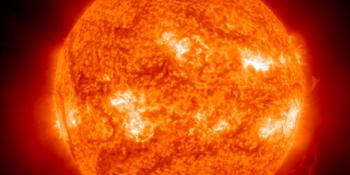Viewing archive of Tuesday, 13 March 2012
Solar activity report
Any mentioned solar flare in this report has a scaling factor applied by the Space Weather Prediction Center (SWPC). Because of the SWPC scaling factor, solar flares are reported as 42% smaller than for the science quality data. The scaling factor has been removed from our archived solar flare data to reflect the true physical units.
Report of Solar-Geophysical Activity 2012 Mar 13 2200 UTCPrepared by the NOAA © SWPC and processed by SpaceWeatherLive.com
Joint USAF/NOAA Report of Solar and Geophysical Activity
SDF Number 073 Issued at 2200Z on 13 Mar 2012IA. Analysis of Solar Active Regions and Activity from 12-2100Z to 13-2100Z Solar activity increased to high levels. Region 1429
(N18W62) produced a long duration M7 flare at 13/1741Z associated
with Type II and IV radio sweeps (estimated velocity 1366 km/s), a
1400 sfu Tenflare, and an assymetric-halo CME (plane-of-sky velocity
1375 km/s) with a mostly northwest trajectory. The geoeffectiveness
of this CME is currently under evaluation.
IB. Solar Activity Forecast
Solar activity is expected to be low
to moderate with a slight chance for an X-class flare until Region
1429 rotates off the visible disk on 15 March. Day 3 (16 March)
solar activity is expected to decrease to low levels with a slight
chance for isolated moderate activity.
IIA. Geophysical Activity Summary 12-2100Z to 13-2100Z
The geomagnetic field was quiet to unsettled. The greater than 10
MeV and greater than 100 MeV protons became rapidly enhanced just
after the M7 flare with associated CME. The greater than 10 MeV
event began at 13/1810Z, reached a maximum flux of 469 PFU at
13/2045Z and is decreasing. The greater than 100 MeV event also
began at 13/1810Z, reached a maximum flux of 18.9 PFU and is also
decreasing. The greater than 2 MeV electron flux at geosynchronous
orbit reached high levels during the period.
IIB. Geophysical Activity Forecast
Geomagnetic activity is
expected to be at quiet levels on days one and two (14 and 15
March). Activity is expected to increase to quiet to unsettled
conditions on day 3 (16 March) due to a recurrent coronal hole
high-speed stream.
III. Event Probabilities 14 Mar to 16 Mar
| Class M | 70% | 70% | 20% |
| Class X | 20% | 20% | 01% |
| Proton | 99% | 90% | 80% |
| PCAF | red | ||
IV. Penticton 10.7 cm Flux
Observed 13 Mar 141 Predicted 14 Mar-16 Mar 140/140/135 90 Day Mean 13 Mar 125
V. Geomagnetic A Indices
Observed Afr/Ap 12 Mar 028/037 Estimated Afr/Ap 13 Mar 010/011 Predicted Afr/Ap 14 Mar-16 Mar 005/005-005/005-007/008
VI. Geomagnetic Activity Probabilities 14 Mar to 16 Mar
| A. Middle Latitudes | |||
|---|---|---|---|
| Active | 10% | 10% | 10% |
| Minor storm | 01% | 01% | 05% |
| Major-severe storm | 01% | 01% | 01% |
| B. High Latitudes | |||
|---|---|---|---|
| Active | 15% | 15% | 15% |
| Minor storm | 20% | 20% | 15% |
| Major-severe storm | 10% | 10% | 10% |
All times in UTC
Latest news
Latest forum messages
Incoming & Unnumbered Active Regions 1376AR 3947 221Lasco Coronagraph 9Unspecified geomagnetic activity 1830Have you ever dreamed of the sun? 23
More topicsSupport SpaceWeatherLive.com!
A lot of people come to SpaceWeatherLive to follow the Sun's activity or if there is aurora to be seen, but with more traffic comes higher server costs. Consider a donation if you enjoy SpaceWeatherLive so we can keep the website online!

Space weather facts
| Last X-flare | 2025/01/04 | X1.85 |
| Last M-flare | 2025/01/09 | M1.1 |
| Last geomagnetic storm | 2025/01/04 | Kp5 (G1) |
| Spotless days | |
|---|---|
| Last spotless day | 2022/06/08 |
| Monthly mean Sunspot Number | |
|---|---|
| December 2024 | 154.5 +2 |
| January 2025 | 159.6 +5.1 |
| Last 30 days | 152.6 +32.7 |


